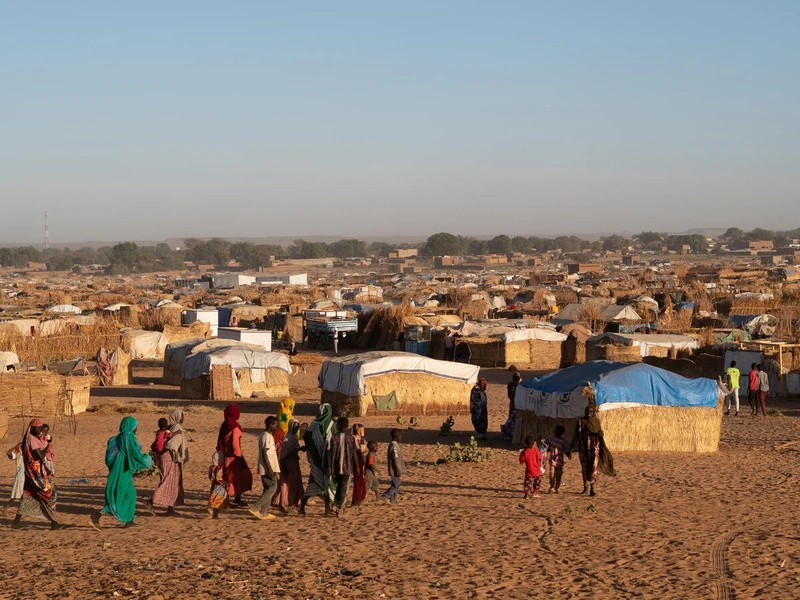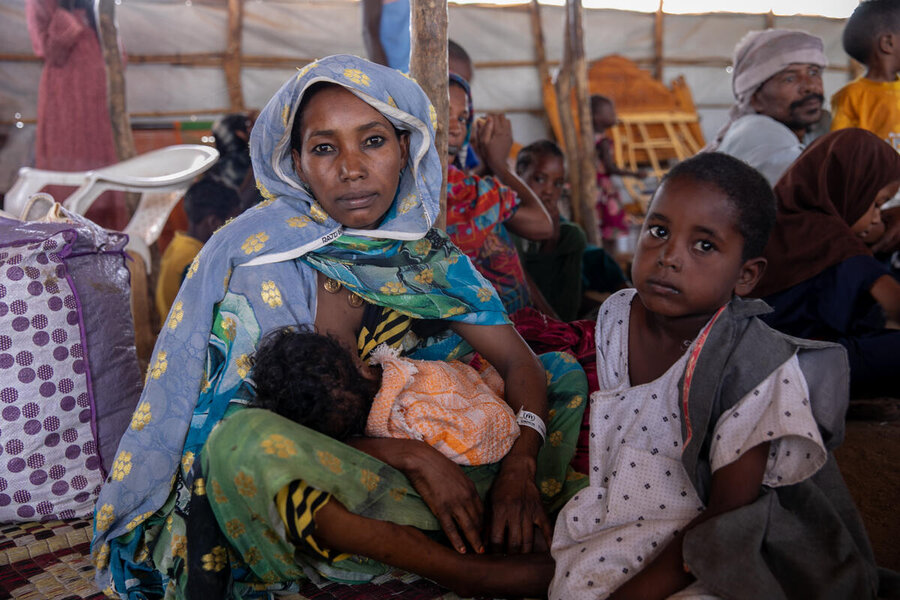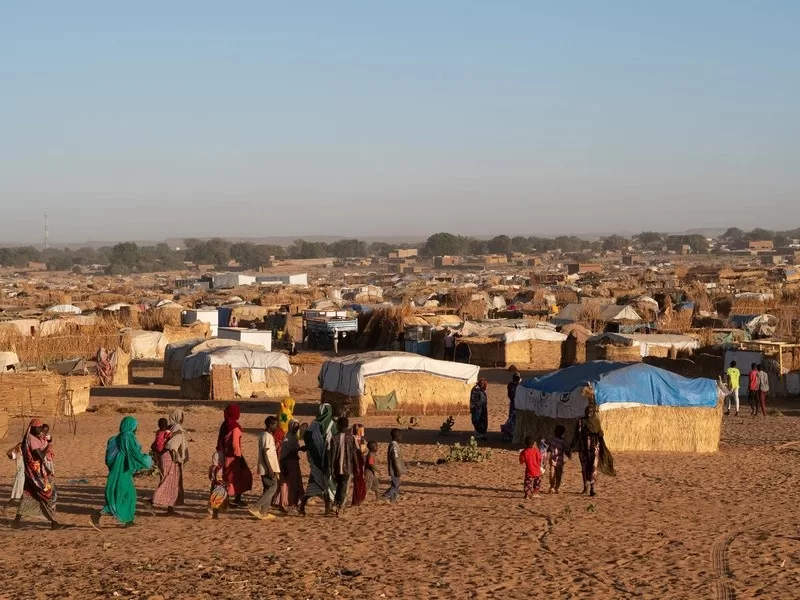When the first shots were fired out in Sudan’s capital, Khartoum, in April 2023, few could have predicted the scale of devastation that would follow. Videos circulated on social media have shown how some took the conflict lightly – with people watching the fight as if it were a sport while sitting on mats and sipping coffee.
What began as a power struggle between Sudan’s paramilitary and military factions, the Sudanese Armed Forces (SAF) and the Rapid Support Forces (RSF), has plunged the country into one of the worst humanitarian crises in recent history. The conflict has crippled Sudan, turning cities into battlegrounds and driving millions away from their homes.
According to the United Nations World Food Programme (WFP), over 10.7 million people have been internally displaced, and over 25 million others face acute hunger. “A further 13 areas of the country are at risk of famine in the coming months,” WFP stated.
As the conflict drags on to its 18th month, the civilian population continues to feel the pain of the violence. Thousands of civilians have been killed, and reports of atrocities committed by both sides of the warring factions continue to surge.
The lack of attention to the dire situation, possibly due to other conflicts such as the one in Ukraine and the Middle East, has made peace advocacy and the flow of aid into the country difficult.
In an interview with Foreign Policy, Alan Boswell, an expert with the International Crisis Group, explained that Sudan has yet to get up to five per cent of the attention conflicts in Ukraine and the Middle East have received.
The struggle for power
Headed by Mohamed Hamdan Dagalo, popularly known as Hemedti, the RSF is a paramilitary group that rose to prominence during the Darfur conflict. The group grew under the infamous Janjaweed militia, which fought for the Sudanese government and was accused of “crimes against humanity”.
After the 2019 ousting of President Omar al-Bashir, RSF and SAF, under the command of the Transitional Sovereignty Council of Sudan, agreed to share power in a transitional government. However, tensions over power, control of resources, and the future of Sudan’s leadership eventually boiled over. In April 2023, an all-out war broke out between the two groups.
The major conflict started over disagreements on integrating the RSF into the military, a key part of the proposed transition to civilian rule. What began as isolated skirmishes in the capital’s suburbs, Khartoum, quickly spiralled into full-scale war, with both factions vying for control of key military installations and government buildings.
But as the world watched the unfolding power struggle, the real tragedy was already taking place far from the halls of power – in the homes, villages, and refugee camps where civilians were forced to feel the wrath of the armed factions. Many were forced to flee their homes to countries like Chad and Egypt.
According to the United Nations, “Since the conflict began 18 months ago, almost three million refugees have fled Sudan, seeking safety in countries such as the Central African Republic, Egypt, Ethiopia, Libya, South Sudan, and Uganda.”
One of the largest refugee camps is located just over the border town of Adré in Chad, where tens of thousands of Sudanese have arrived seeking safety and shelter. Aid workers here struggle to meet the basic needs of the refugees. Clean water is scarce, food supplies are inconsistent, and medical care is almost nonexistent. Diseases like cholera and malaria are spreading rapidly, exacerbated by the camp’s poor sanitation.

Despite these challenges, people have continued to troop in, facing the tumultuous journey, including in the rainy season.
“In the first week of October alone,” the UN said, “close to 25,000 people fled to eastern Chad, marking the highest weekly influx this year. This follows months of intensifying violence in Darfur, and Chad now hosts over 600,000 Sudanese refugees, which is more than any other country in the region.”
Aisha Yusuf, a mother of five, arrived in Chad after fleeing the violence. “We left everything behind,” she says, cradling her youngest child in a video shared on Telegram. “Our home, our land, our animals. The only thing we could take was each other. But here, even survival is uncertain. There is no food, no medicine.”
The number of internally displaced persons (IDPs) continues to skyrocket. By October 2024, more than 8.2 million Sudanese had fled their homes, according to the UN. These IDPs have been trapped within Sudan’s borders, seeking refuge in camps or remote areas far from the fighting.
In cities like Nyala, the capital of South Darfur and Sudan’s second-largest city, new IDPs joined the millions already in the region even before the war. According to the Norwegian Refugee Council, the IDP camps in Nyala face “severe food insecurity and malnutrition, strained health services, disrupted education systems, inadequate shelter, insufficient WASH (Water, Sanitation, and Hygiene) services, and critical protection and security issues”.
Mohammed was among the thousands of Sudanese who fled their country following the start of the conflict. Born and raised in Khartoum, he lived most of his life in relative peace. However, things changed overnight.
He told IOM that when the conflict started, “I was pinned down in my house for 15 days due to the constant fighting. My apartment was located between the opposing armies. There was no way to escape.”
Now living in Egypt as a refugee, Mohammed recounted that “it was a hard journey… it took two long days, and along the way, I witnessed unimaginable horrors, homes being shot at or burned.”
Sara, a mother of four, thought the conflict would only last a few days, but she was wrong. “Armed men would go from neighbourhood to neighbourhood searching homes, raping women, and harassing the men. It was horrible,” she told IOM.
Hunger and starvation
While the war has claimed countless lives through direct violence, hunger and malnutrition have become the silent killers of Sudan’s humanitarian crisis. The war has crippled the country’s agricultural sector, with supply chains severed, markets destroyed, and farmers forced to flee their land.
The UN estimates that almost half of Sudan’s population needs humanitarian assistance. In some areas, food prices have more than doubled, leaving families unable to afford even the most basic staples like bread and rice.
In August, Edem Wosornu, Director of Operations and Advocacy, UN Office for the Coordination of Humanitarian Affairs, described the humanitarian situation as “an absolute catastrophe,” citing a staggering 26 million people in acute hunger — three times the population of New York City.
The WFP has warned that Sudan could face widespread famine without immediate action in the coming months. “Our warnings have not been heard,” said Stephen Omollo, the organisation’s Assistant Executive Director for Workplace and Management, recalling their previous alerts about a widespread collapse in food security.
“Sudan is critically underfunded,” he said, highlighting that the humanitarian appeal for the country is just 32 per cent funded — having received $874 million out of the $2.7 billion needed.

Healthcare in crisis
As the war rages on, Sudan’s healthcare system has collapsed. Hospitals have been bombed, clinics looted, and medical supplies are running dangerously low. The few facilities that remain operational are overwhelmed, struggling to treat the influx of wounded civilians and those suffering from preventable diseases.
Organisations such as Médecins Sans Frontières (MSF) have also faced challenges in offering humanitarian health services. In October, MSF published that it has been forced to stop caring for thousands of malnourished children due to a blockade.
“Warring parties have blocked the delivery of food, medicines, and supplies to Zamzam camp for months,” the humanitarian organisation said. “We were forced to stop outpatient care for 5,000 children with acute malnutrition living in Zamzam camp for displaced people in Sudan at the end of September.”
A research published in March 2024 revealed that over 200 violations against medical staff were recorded all over Sudan, which led to the death of 38 healthcare workers. The killing, kidnapping, and assault of doctors consequently led to a huge shortage of staff in the few barely working facilities, as the remaining health workers were concerned regarding their safety.
In Khartoum and Omdurman, the war between RSF and SAF has made doctors work more tasking. Most hospitals in these regions have been shut down because of a lack of supplies, staff, and funding or because the fighting has destroyed them. Doctors like Jamal Mohammed have been working with no pay since the start of the war.
The situation is equally grim in rural areas. In Darfur, where healthcare was already limited before the conflict, the destruction of clinics has left entire communities without access to medical care. Reports indicated that pregnant women are giving birth in unsafe conditions, children are dying from treatable illnesses like diarrhoea and pneumonia, and chronic diseases like diabetes and hypertension are going untreated.
In overcrowded camps and urban areas where sanitation has broken down, cholera, malaria, and measles are spreading at alarming rates. With vaccination campaigns disrupted and basic hygiene supplies like soap and clean water in short supply, the risk of epidemics looms large.
The international response
With little attention given to the humanitarian crisis in Sudan, the international response has been slow and inadequate. Aid agencies, including the United Nations and the Red Cross, have called for immediate action, but the ongoing fighting and a lack of funding have hampered their efforts.
Diplomatic efforts to broker a ceasefire have repeatedly failed. Regional actors like Egypt, Saudi Arabia, and the African Union have attempted to mediate between the warring factions, but neither side seems willing to make the necessary concessions.
International sanctions have also been imposed on both the RSF and the Sudanese Armed Forces, but these measures have done little to stem the flow of arms and ammunition into the country.
In October, the United States imposed sanctions on a senior leader of RSF, Hamdan Daglo Musa (Algoney), for his involvement in RSF efforts to procure weapons and other military equipment.
Some experts have called for a comprehensive arms embargo, but with external actors backing both sides of the conflict, the likelihood of this being implemented remains slim.
The Sudanese government has accused the United Arab Emirates (UAE) of supporting the RSF, while the RSF accused Egypt of supporting the SAF.
War crimes and atrocities
The war in Sudan has not only created a humanitarian disaster but has also given rise to widespread human rights abuses. Both the RSF and the Sudanese Armed Forces have been accused of targeting civilians, committing acts of sexual violence, and engaging in extrajudicial killings.
In Darfur, the RSF has been accused of carrying out ethnic cleansing against non-Arab communities, particularly the Masalit and Fur ethnic groups. Survivors recount horrific stories of entire villages being burned to the ground, women and girls being raped, and men being summarily executed.
Human rights organisations have documented mass graves and other evidence of these atrocities, calling for international investigations into potential war crimes.
In 2023, the UN investigated 13 mass graves believed to contain civilians from the ethnic Masalit tribe who were killed in attacks by the paramilitary Rapid Support Forces (RSF) and allied Arab militias.
Despite these reports, accountability remains elusive. The International Criminal Court (ICC) has opened an investigation into crimes committed during the conflict. Still, with both the RSF and SAF continuing to operate with impunity, it is unclear whether justice will ever be served.
__________________________________________________________________________________________________________
As the war grinds on, the future of Sudan hangs in the balance. The country’s once-promising transition to civilian rule has been derailed, and the prospect of peace seems increasingly distant. With both sides entrenched in their positions, the risk of a prolonged conflict looms, and the longer the war drags on, the harder it will be to rebuild.
For the millions of Sudanese civilians caught in the crossfire, survival is the only priority. In refugee camps and war-torn cities, they cling to the hope that one day, the fighting will end, and they can return to their homes.
For now, Sudan remains a nation on the brink, its fate uncertain, its people suffering, and the international response far from adequate.
